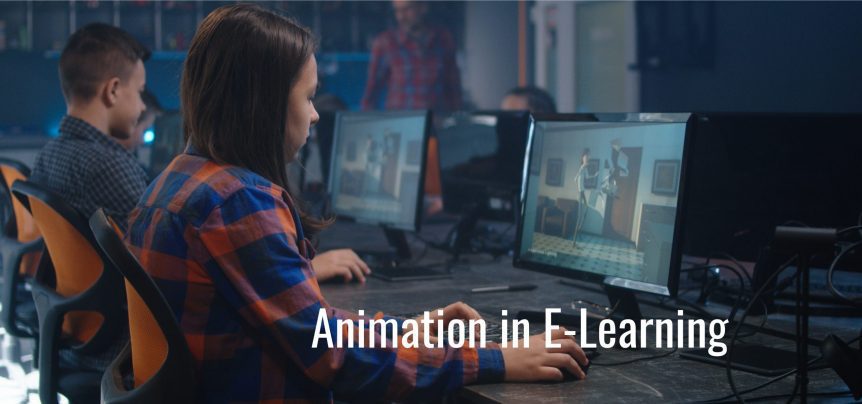Benefits of Using Animation in E-Learning
One of the main advantages of choosing e-learning over other forms of training is the ability to include different types of content using a variety of media. This includes animations.
Why should you include animations in the e-learning courses you create? From simplifying information to making content more relatable to improving learning outcomes, animations offer a range of benefits in e-learning.
Animation is Engaging
One of the key goals of any training content, module, or course is to engage the learner. Without engagement, it is unlikely the learner will effectively understand the topic or obtain the required new skills. Therefore, it is essential to add content to your e-learning courses that improve levels of engagement.
You can do this with animations. Most people would prefer to watch a 60-90 second animation rather than read a page or two of text.
Learners Will Be Familiar with Watching Animations
The learners completing your e-learning course will also be familiar with animations. They encounter them on social media, when browsing the internet, when shopping, in the entertainment they consume, and more. This familiarity helps to break down barriers between the course content and the learner to get them more involved with the course.
Ideal Method of Simplifying Complex Information
This is one of the main benefits of animation in general, and it certainly applies to e-learning situations too. With an animation, you can include sounds, speech, text on the screen, static images, graphs, moving images, and calls to action, all within a single 60-second video.
This allows you to explain even the most complex of topics succinctly and in a way that learners will understand.
Good for Explaining Information and Ideas Quickly
Following on from the above point, the different elements you can include in an animation result in learners understanding information faster than with many other forms of content presentation.
Highly Effective at Setting a Tone
Adding an animation to your e-learning course makes it much easier to set the right tone compared to other forms of content.
For example, it is difficult with text or an image to encourage learners to get on-board with a new idea, inspire them to improve performance, or appeal to them to change behaviour.
This is much easier with an animation, particularly in relation to sounds and voiceovers.
Excellent Way of Introducing New Concepts
Another highly effective way to use animations in e-learning is to introduce a new concept. This can be one of the most challenging aspects of creating e-learning courses. If the concept introduction doesn’t go well, you risk losing the interest and engagement of the learner for good.
With an animation, however, you can introduce the concept in an engaging, fun, and simplified way, setting up the rest of the course for you to go into the topic in more detail with text and other types of media.
Concise Method of Presenting Information
Concepts and ideas that require paragraphs of text to explain can be a challenge for many learners. However, you will find you can often replace those paragraphs of text with a short animation, getting the same information across.
Enables Multi-Sensory Learning
Many learners respond better to multi-sensory experiences where they feel more involved with and connected to the content being presented to them. You can achieve this with animations.
Makes Knowledge More Accessible
You are likely to have different types of learners completing your e-learning course. Different types of learners learn in different ways. For example, some will respond to reading and rote learning, but others won’t.
Animations appeal to most learners, regardless of the pace of learning or content preference. As a result, animations can make the content you include in your e-learning course more accessible.
Makes Content More Relatable
Often the most effective types of animation in e-learning are those that make the content personal and relatable. Doing this helps learners to engage with the animation and also get a better understanding of the information you are presenting.
One way of doing this is to present a character with a realistic problem who then uses new knowledge or skills to find a solution. This is more effective than dryly presenting the information without a story.
Animations Are Entertaining
Good animations are entertaining, so learners will enjoy watching them. However, this is not about making animations entertaining for entertainment’s sake. Instead, the entertaining nature of animations makes them more memorable, so helps to improve knowledge retention.
Capture the Attention of Learners
This point applies to all types of e-learning course, but it can be particularly beneficial if the topic of the course is dull. This can include essential compliance courses, for example, i.e. courses where it can be a challenge to spark the interest of your team.
Adding an animation can bring the e-learning course to life, getting the attention of learners and improving outcomes.
Improve Learner Satisfaction
Many of the above points combine to improve the satisfaction levels of learners in your e-learning courses overall. As with other points, this is important to helping you achieve your training objectives, i.e. learners who enjoyed an e-learning course and felt it was worthwhile are more likely to look positively on future training courses.
Possibility for Re-Use
Finally, in some cases, it is possible to re-use animations you create for e-learning courses in other mediums and formats. For example, you might create an animation to explain a new product to help your salespeople present it to customers. This animation could then be re-used on your social media channels to build awareness of the product in the marketplace.
Investing in Animation for E-Learning
Animations in e-learning can bring complex or dull topics to life, enhancing the experience of learners and, crucially, improving the outcomes of training courses. In other words, animations can help you achieve your objectives, so deliver a positive return on investment. While they may not be suitable in all e-learning modules, they are a powerful training tool.

